
MAY CONTAIN NUTS

Search Shorpy
SHORPY ART

Framed or unframed, desk size to sofa size, printed by us in Arizona and Alabama since 2007. Explore now.
Join and Share
Ad-Free Shorpy
Shorpy is funded by you. Patreon contributors get an ad-free experience.
Learn more.

Recent comments
- Texas Flyer wanted
- Just a Year Too Soon
- WWII -- Replacing men with women at the railroad crossing.
- Yes, Icing
- You kids drive me nuts!
- NOT An Easy Job
- I wonder
- Just add window boxes
- Icing Platform?
- Indiana Harbor Belt abides
- Freezing haze
- Corrections (for those who care)
- C&NW at Nelson
- Fallen Flags
- A dangerous job made worse
- Water Stop
- Passenger trains have right of way over freights?
- Coal
- Never ceases to amaze me.
- Still chuggin' (in model form)
- Great shot
- Westerly Breeze
- For the men, a trapeze
- Tickled
- Sense of loneliness ...
- 2 cents
- Charm City
- What an Outrage
- Brighton Park
- Catenary Supports
Member Photos
The Shorpy
Print Emporium
Print Emporium
Search Shorpy
Search results -- 30 results per page
- The Cardigan Cowboy: 1941
- ... at the Quarter Circle U, Brewster-Arnold Ranch Co. Birney, Montana." Our second visit with this sweater-wearing wrangler. Photo by Marion ... bitting.
It can be hot as blazes -- or not -- in Montana summers, so the straw hat is cooler than the felt style hats.
(The ... Posted by Dave - 08/05/2015 - 12:04pm -
![The Cardigan Cowboy: 1941 August 1941. "Cowboy and horse at the Quarter Circle U, Brewster-Arnold Ranch Co. Birney, Montana." Our second visit with this sweater-wearing wrangler. Photo by Marion Post Wolcott for the Farm Security Administration. View full size.
A Horse NamedBlasé.
Handsome RakesTime to add the tag to this guy, because he is one. Sure, not in the iron worker way, but rather in the ranch hand way!
[Done. - Dave]
UnbridledInteresting that the horse is not wearing a bridle, but rather a halter. The bridle has a bit, which goes in the horse's mouth, and is used to control the animal. A halter is generally used only to lead them. Somebody more horse savvy than I am might be able to shed light on this.
Hackamore not halterThe horse is not wearing a halter, but a hackamore bridle. The nosepiece is called a bosal. These are more common in California and Texas -- in the old California style, the young horses are worked in the hackamore, slowly transitioning to the large and heavy spade-style bitting.
It can be hot as blazes -- or not -- in Montana summers, so the straw hat is cooler than the felt style hats.
(The Gallery, Handsome Rakes, Horses, M.P. Wolcott)](https://www.shorpy.com/files/images/SHORPY-8c31415a.thumbnail.jpg)
- On the Road: 1936
- ... Evans and family of Lemmon, South Dakota, near Missoula, Montana, Highway 10. Leaving the grasshopper-ridden and drought-stricken area ... Posted by Dave - 08/22/2012 - 7:43am -
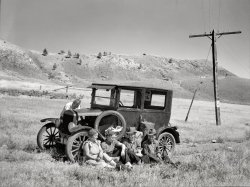
- Frozen Motors: 1942
- March 1942. "Lewistown, Montana. Used car lot." Medium format acetate negative by John Vachon for the ... Posted by Dave - 11/24/2021 - 11:38am -
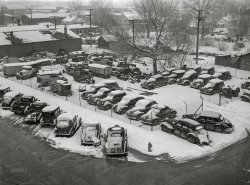
- Hotel Rainbow: 1941
- ... "Buildings on main street of ghost town. Judith Basin, Montana." Medium format negative by Marion Post Wolcott for the Farm Security ... View full size.
Geyser MT It's Geyser, Montana. The bank building is still there.
No Vacancy Except for Ghosts ... Posted by Dave - 02/14/2020 - 10:55am -
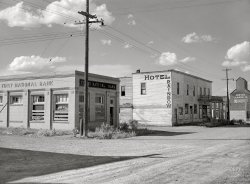
- Blatz on Tap: 1939
- Summer 1939. Butte, Montana. "Men lounging in front of the Arcade." 35mm negative by Arthur ... Posted by Dave - 09/20/2010 - 9:02pm -
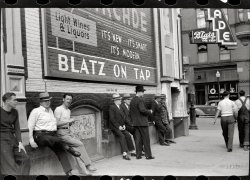
- Zaza: 1939
- Summer 1939. "Amusements at carnival, Bozeman, Montana." Zaza in Bozeman -- has a certain ring to it, no? But we digress. Pony ... Posted by Dave - 09/09/2010 - 11:00am -
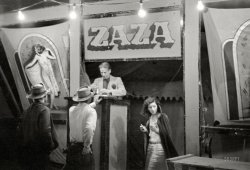
- Langley Field: 1942
- ... for this photo. Car headlights? It brings to mind the Montana cowboys photo seen previously on Shorpy.
[Below, a glimpse of ... Posted by Dave - 08/30/2012 - 3:28pm -
![Langley Field: 1942 May 1942. "Here's our mission." A combat crew receives final instructions just before taking off in a mighty YB-17 bomber from the bombardment squadron base at Langley Field, Virginia, nation's oldest air base. View full size. 4x5 Kodachrome transparency by Alfred Palmer for the Office of War Information.
ShoesIs the second man from the right wearing wing-tip shoes? Looks like it to me. I know officers had to buy their own uniforms, so their uniforms weren't necessarily G.I., but wing-tips? Weren't there rules beyond the color specification of brown?
Langley CrewI'm curious about how these fliers were illuminated for this photo. Car headlights? It brings to mind the Montana cowboys photo seen previously on Shorpy.
[Below, a glimpse of Alfred Palmer's floodlight. - Dave]
Stunning imageThe composition and lighting in this photo are beautiful.
Pinks and brown shoesI agree, although I've heard that old school pilots (pre WW-II) would buy a pair of cowboy boots upon graduation from UPT. Seems like the flight engineer, or whoever has the greasy overalls, is wearing boots with undershot heels. FYI pinks is a term used for the tan twills used up to the 60's. They seemed to take on a pinkish cast in some light.
(The Gallery, Kodachromes, Alfred Palmer, Aviation, WW2)](https://www.shorpy.com/files/images/1a35094u.thumbnail.jpg)
- Shoulda Been a Cowgirl: 1941
- ... U Ranch at Crow Indian fair. Crow Agency, Big Horn County, Montana." Medium format negative by Marion Post Wolcott for the Farm Security ... before the storm A relaxing summer day on a ranch in Montana, but this atmosphere would evaporate in three months -- as would the ... Posted by Dave - 03/04/2018 - 8:54pm -
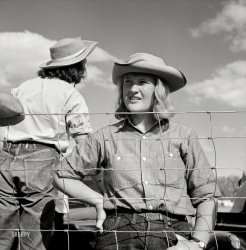
- Pan-American: 1935
- ... on a bicycle back in the 1970s
including a parts of Montana and Wyoming in 1976.
Gee, I wonder why my knees hurt so much these ... Posted by Dave - 10/18/2015 - 7:32pm -
![Pan-American: 1935 Ready for international bicycle ride. Henry G. Slaughter of Washington, supported by those interested in publicizing the Inter-American Highway, prepares to leave for a trip which will carry him, if he is successful, down into the tropics through Central America to the Argentine.
November 23, 1935. Washington, D.C. "Henry G. Slaughter." Harris & Ewing Collection glass negative. View full size.
BustA blurb in the Loredo Times from Feb. 6, 1936 reported that Mr. Slaughter decided to abandon "the idea." He had written a friend that he had encountered delays in entering Guatemala on account of very strict laws of entry, and now that the rainy season had begun in that country he had decided to abandon the trip. By June 1936, however, The Carthage Watchman reported that Henry and his handlebar-based typewriter were about to make a second attempt.
Foot HelpI have no idea what was available back in the day, but riding without at least toe clips makes it a lot harder when climbing.
I logged many thousand miles on a bicycle back in the 1970s
including a parts of Montana and Wyoming in 1976.
Gee, I wonder why my knees hurt so much these days?
If you look hardyou can see the revolution counter on the front fork and the pin to turn it on one of the spokes.
I'll wager -I'll bet that he doffs his necktie before he reaches San Luis Obispo.
[Which would have been a major detour on a trip from D.C. to Argentina. - Dave]
Wobble InstabilityYou can pile any amount of stuff as high as you want on a bicycle so long as it doesn't flex under side forces.
Otherwise the bike goes unstable. The front bag looks bad in this regard unless it's all rigid. Also it blocks his light from shining on the road, which in 1935 is surely all potholes.
So I'd guess he didn't make it, unless he piled the front bag in the back and strapped it down.
Incomplete PreparationThis guy isn't fully prepared for such a long trip and doesn't appear to understand what's cool.
For example, he has no streamers coming out of his handlebars, and no playing cards rubbing against his spokes. Nor does he have a hub polisher on either wheel.
Not to mention he's not wearing a bow tie and a houndstooth suit.
Pure Amateur Hour.
I bet he didn't make it.
Story of EvolutionEarly nerd.
Panama or BustHenry had just left San Antonio, Texas and bound for Panama a week after this photo, Methinks there are some inaccuracies abounding. See attached article from the San Antonio Light, published 30 November 1935.
Not So Fast!Seems Henry did make it as far as Panama. May of 1936 had him in front of the US Capitol after a 3400 mile trip. He made the front page of the Erie County Independent. (NY)
At that point he has a typewriter attached to his handlebars to ". . . type notes. . . " - I bet the paper was beat up by the bottom of the page.
Pith Helmet and Linemans bootsJust like they use in the Tour de France.
Wobble InstabilityForgive me for posting twice, but rhhardin's comment about Wobble Instability reminded me of the enormous front basket I had on my one speed J.C. Higgins nerd bike when I was a kid so I could deliver papers.
It had so much weight forward, especially with a load of papers, that I had to be extremely careful making turns, and I dumped it more than once.
I learned to hate that hill I had to climb halfway through my route, and envied those "rich kids" who had parents that could afford one of them "English racers".
(The Gallery, Bicycles, D.C., Harris + Ewing)](https://www.shorpy.com/files/images/SHORPY-39654a.thumbnail.jpg)
- On the Road: 1936
- July 1936. "Drought refugees from Glendive, Montana, leaving for Washington state." View full size. Medium format ... Posted by Dave - 07/30/2012 - 10:51am -
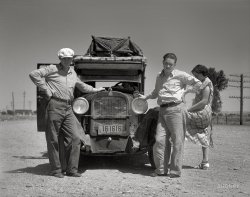
- Behind the Scenes: 1938
- ... chassis.
Bargain Basement Are you sure this is not Montana? I see Butte.
At least we are not seeing junk this time.
... Posted by Dave - 09/11/2011 - 10:38am -
![Behind the Scenes: 1938 September 1938. Westover, West Virginia. Marion Post Wolcott and her intrepid camera head downstairs: "Miner takes shower, which he built in the cellar of his home." View full size. Medium-format negative, Farm Security Administration.
Who'll Hold the Camera?And the next photo shows Marion wedged under his chassis.
Bargain BasementAre you sure this is not Montana? I see Butte.
At least we are not seeing junk this time.
Seriously, why put a shower downstairs? This has to be one of the oddest pictures you have unearthed yet.
[Probably because there's no bathroom upstairs. - Dave]
Basement ShowerMany miners, farmers and others who get very dirty at work have showers in the basement so that they don't spread the coal dust/dirt through the house.
Basement ShowerMy grandfather built a shower in the basement of his family's farmhouse in New Martinsville, WV back in the 40's. Until the late fifties that was the only bathroom plumbing in the house. A two-tub sink and a full mirror, along with a medicine cabinet and shelf for towels stand beside it. It's still where we're instructed to go when we get dirty working 365 acres of land. This picture is every bit of familiar to me.
Mining PhotosOne of the most extensive collections of Mining Photography and mining artifacts is located within the West Virginia State Archives and State Museum Collection at the Cultural Center in Charleston. I have compared the faces of miners in the hand-loading era with those of sailors in the sail era. They are strikingly similar. I guess the stress and strain of an extremely dangerous, and physically demanding job took its toll all who were there.
[Was there something memorable about this face in particular? - Dave]
(The Gallery, M.P. Wolcott, Mining)](https://www.shorpy.com/files/images/8c29836u.thumbnail.jpg)
- The Buggy Company: 1903
- ... the photo on Shorpy, I watched an old Errol Flynn movie "Montana", and there was "Cuddles" playing his usual lovable self. For anyone ... Posted by Dave - 08/21/2012 - 6:31pm -
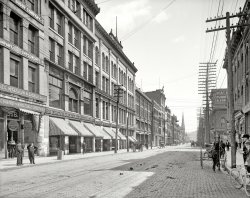
- Just Ridin' a Beaver
- This was taken in Eastern Montana around 1927-29. Mary, my grandmother riding the beaver, was born in ... would be dead..... This photo would have been taken in Montana at a log cabin in the hills. These folks (and my father as well)would ... Posted by pcayer - 10/29/2007 - 10:53pm -
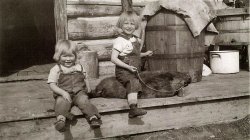
- Camp Flying Eagles: 1908
- ... there would be no Boy Scouts. Burnham wore a hat with a "Montana peak" we now know that as a campaign hat. B-P adopted this hat for it's ... Posted by Dave - 10/27/2019 - 3:24pm -
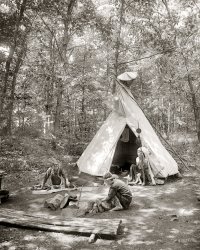
- Big Sky: 1939
- ... on Henry Sheffels' 6,000-acre wheat ranch. Cascade County, Montana." Medium format acetate negative by Arthur Rothstein for the Farm ... this photo for a minute I realized that my father was in Montana with the CCC around this time. I believe he was near Missoula which ... Posted by Dave - 12/12/2017 - 2:53pm -
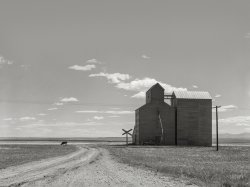
- Deadwood From Forest Hill: 1888
- ... and glass insulators (1904 began use in western SD/eastern montana)in the second picture. i wonder if your date is a bit out since the ... Posted by Dave - 01/19/2014 - 10:29am -
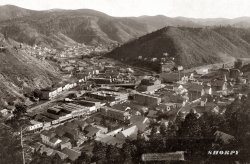
- Con Carny: 1939
- Summer 1939. Carnival at Bozeman, Montana. View full size. 35mm nitrate negative by Arthur Rothstein for the ... Posted by Dave - 04/25/2008 - 10:34pm -
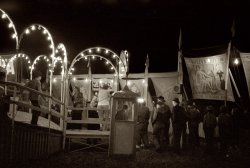
- Store Greeter: 1942
- September 1942. "Park County, Montana. Oat harvest." Medium format negative by Russell Lee for the Office of ... to be quite a ways up?
Who knew? In parts of Montana in the recent past, oats were grown in town and the reaper was pulled ... Posted by Dave - 07/18/2017 - 11:53am -
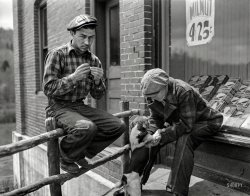
- Skeet's Cafe: 1942
- August 1942. "Dillon, Montana. Street corner. Dillon is the trading center for a prosperous cattle ... Posted by Dave - 04/06/2013 - 11:55am -
![Skeet's Cafe: 1942 August 1942. "Dillon, Montana. Street corner. Dillon is the trading center for a prosperous cattle and sheep country." The cafe seen earlier here. Medium-format nitrate negative by Russell Lee for the Office of War Information. View full size.
Same motorcycle in both pics?I see that there is a motorcycle parked in almost the same spot in both pics. I wonder if the owner worked in the building, or just ate lunch there a lot.
[The two photos were taken the same day a relatively short time apart from one another. Lee had one camera loaded with black-and-white 120 roll film and another large-format camera capable of taking Kodachrome sheet film. - tterrace]
Street view?I was curious to see if I could find this building on Google Street View, but...
[See the link to the other photo in the caption; the comments to it include a Google street view. - tterrace]
Check out them dungarees!
Late '30s Harley-Davidson VLThe bike is likely a Harley VL, and it looks to be a later model (1935 or 1936) from the shape of the sheet metal.
What is it?What is the extra red light fixture on the same pole as the corner street lamp for?
Red light In the days before radios in police cars or officers on patrol carrying radios some police headquarters would turn on a light on the street and the officer would either contact or report to headquarters.
(The Gallery, Eateries & Bars, Motorcycles, Russell Lee)](https://www.shorpy.com/files/images/SHORPY_8d22381a.thumbnail.jpg)
- Military Exercise: 1917
- ... man has a campaign hat (a.k.a. Smokey Bear hat) with the "Montana" peak; this was standard issue for Army and Marines until about 1942. ... Posted by Dave - 08/07/2012 - 11:05am -
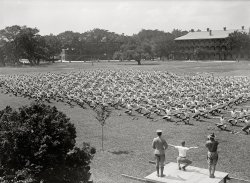
- Bathtime for Joey: 1943
- ... size. Epilogue: Joe, a lawyer, died in March 2000 in Montana. His dad, Hugh, died two years later. Lynn, a mother of eight, passed ... move in the seventies when she ran for the state Senate in Montana--and nearly won. If it had been after Watergate instead of before, she ... Posted by Dave - 09/09/2011 - 11:01am -
![Bathtime for Joey: 1943 December 1943. "Lynn Massman, wife of a second class petty officer studying in Washington, D.C., giving eight weeks old Joey his daily bath." The Massman family was the subject of dozens of photos shot by Esther Bubley for the Office of War Information. View full size. Epilogue: Joe, a lawyer, died in March 2000 in Montana. His dad, Hugh, died two years later. Lynn, a mother of eight, passed away in 1983 after a very active life. Click here for remarks by her son Bascomb.
Any info on Lynn?When did she die?
[In 1983 (see above). More on the Massmans in this thread. - Dave]
Lynn MassmanLynn died before her sister Elaine passed away in 2001. Elaine's obituary.
[Thanks, Joe. - Dave]
Lynn's passingI'm Lynn's sixth child. Her fourth son. She died in 1983 of cancer. She would have made a great old lady.
[Thanks for filling in the gaps. - Dave]
More on LynnThe confusion could have been caused by her name change. When Lynn died she had not only remarried to Julius "Babe" Stoner, but she had taken to spelling her name Lyn. She made that move in the seventies when she ran for the state Senate in Montana--and nearly won. If it had been after Watergate instead of before, she probably would have won.
Re: JoeyThe size of Joey at eight weeks doesn't surprise me. All three of my sons were also chunky at eight weeks. Their pediatrician instructed me to start my sons on baby cereal at two weeks with pureed fruits and vegetables.
By around six weeks, I was instructed to add pureed beef roast or chicken into their cereal for dinner.
Of course this was served in tiny amounts off of a baby spoon.
My sons also slept through the night around six weeks of age. Now I have three strong teenage sons and not one of them has an allergy. Go figure!
JoeyJust have to ask - are you sure that's an 8 WEEK old baby and not 8 MONTHS??? I'm sorry to question, but my baby is just about to turn 18 months next week and she was not anywhere near the size of Joey in this picture until 8 or 9 months, and she was 8 lb 2.5 oz at birth and has remained in the higher percentiles of weight & height to date!
[Eight weeks seems to be correct. Joey was born in October 1943. - Dave]
Joey MassmanThe Massmans are all big folks. Joe was 6 foot 2 and about 275 pounds before the cancer thinned him down in his last weeks. I'm 6'5 and 210. My daughters were both over 10 pounds at birth. I always say "Massman" is just another way of saying "big guy."
(The Gallery, D.C., Esther Bubley, Kids, Massman, WW2)](https://www.shorpy.com/files/images/8d41938u_0.thumbnail.jpg)
- Co-op Gas: 1941
- ... elevators in Minot, North Dakota, dude ranchers in Birney, Montana and a farm family in Laredo, and main street in Sheridan, Wyoming.
... Posted by Dave - 02/13/2020 - 8:31pm -
![Co-op Gas: 1941 August 1941. "Cooperative gas station in Minneapolis, Minnesota." Medium format acetate negative by Marion Post Wolcott for the Farm Security Administration. View full size.
Co-Op Doo-WopThis photo has a very 1950s look to it. I suppose life, fashion, architecture and design in particular, took a break during the '40s while all efforts focused on WWII. Sometimes I wonder how different the 1950s would have been if the war had never taken place.
I only know of co-ops in New York CityI thought co-ops were member owned apartments in the Big Apple. Well, they are.
I didn't know about other co-op ventures, like this service station. By the way, if you look by the left shoulder of the attendant, you'll see Walker Mufflers for sale.
I did a search on Walker exhaust and muffler systems, and by golly, they are still in business.
The things you find out here --
Neon TowerI'd love to see a night photo of this Moderne gas station, since the tower has lots of neon tubing on it. There is some neon around the overhang as well. Canada has lots of Co-op gas stations, particularly on the Prairies and in the West. Here is a list of Co-op stations on Vancouver Island, with the Canadian term "gas bar" used.
Fill it Up?Just think, most people under 40 or so have never had a person come out and fill up their tank at the gas station.* I remember the first time I had to do it myself. It was down south in 1976. We ended up with self-serve up north where I lived a few years later.
[*Unless you live in New Jersey or Oregon. - Dave]
TiresI remember when they came spiral-wrapped in brown paper.
August 1941Four more months that pile of tires will be just a memory. All the rubber for the war effort among a host of other sacrifices by Americans and their families.
Co-OpedThere was a Co-Op gas station in my home town in central Ohio in the 1950s and '60s. It was part of the Farm Bureau agricultural supplies center, which was run as a cooperative with local farmers.
CO-OP ragtopWow! All the way from Virginia in a 1941 Buick convertible (rag top).
Probably not many convertibles in Minneapolis due to the short top down season and long northern winters. Pre-war good times.
Red River Co-opThe full name of the Co-op gas stations and supermarkets in Manitoba is Red River Co-op. Photos below are of Winnipeg, my hometown.
The Virginian brideA plausible candidate for the driver of the car in the Minneapolis gas station in August 1941 with Virginia plates is photographer Post Wolcott. Before the war and rationing FSA photographers drove more than they hopped trains. We know Marion Post had wed Leon Oliver Wolcott by August because her colleague John Vachon reported the news to his wife Penny in a June 27, 1941 letter. Her groom was a deputy director of a section of the Department of Agriculture, and in her 1965 oral history she explained that her marriage came with two children and a farm. Her Smithsonian bio places the farm in Virginia. Before August 1941 was over, her car had reached grain elevators in Minot, North Dakota, dude ranchers in Birney, Montana and a farm family in Laredo, and main street in Sheridan, Wyoming.
Massachusetts has a local option Attendant required to fill tank in the next town over.
Yeah, it's weird. Since only the folks who live there are inexperienced at filling their own tanks. The rest of us come from places where we're trusted to manage on our own. It's a "safety" thing, I guess, like the stickers requiring you to turn off your cellphone while filling, which seem to have disappeared.
(The Gallery, Cars, Trucks, Buses, Gas Stations, M.P. Wolcott, Minneapolis-St. Paul)](https://www.shorpy.com/files/images/SHORPY-8c15191a.thumbnail.jpg)
- TTerrace Terraces: 1979
- ... a little garden behind a little house in a little town in Montana, but I remember sitting out there on summer evenings eating baby ... Posted by tterrace - 10/01/2011 - 3:18pm -
![TTerrace Terraces: 1979 Actually, my father's terraces, and there he is at the upper right, at age 77 still taking care of this whole place. Pretty much everything you see here exclusive of the house is his doing. The basic grading had been done by the time my folks bought the place in 1941, but over the years he put in all the pathways, stairs, trees, bushes and other plantings, here as well as the other half of the property. This just most of the back yard, site of the orchard and vegetable gardens. He's preparing one of the three tiers of the latter for planting. I think those are strawberries already sprouting. Later there'd be beans, corn, tomatoes, zucchini and squash. The fruit trees include apples, peaches, plums, prunes, apricots, figs and cherries. The one in the center casting a shadow on the bank of pink-blossoming oxalis is an avocado that grew for decades before finally producing some finger-sized fruit. A row of blackberries follows the stairway, which is lined by amaryllis. When, at the age of 11, I incorporated the yard as the City of Penton, I named those pathways, left to right: Plum Blvd., Compost Rd. (because the compost heaps used to be there) and Garage Ave. (because that's where the stairs went). The square thing above the avocado tree is the platform of my observatory. This Kodachrome slide was at the end of the roll, hence the phantom image of a batch tag or something at the right edge. View full size.
A Natural TalentYour father was gifted as a born landscape architect, although I'm pretty sure he didn't consider himself as such. There is so much to see here, so many facets of gardening are represented and so much hard work that must have taken many years to develop, not to mention the physical effort and time he put in to beautify and create this bountiful backyard. My parents and grandparents did similar cultivation of the earth's rewards, nothing as elaborate as yours, but I did not inherit their penchant for growing things. I wonder if youngsters today even realize that most of their food comes from seeds that require loving care, rain and sunshine to grow into delicious nourishment and/or beautiful flowers (food for the soul). Your father had to be extremely proud of his creation, it is quite magnificent.
What a wonderful place!This would have been an awesome playground for an imaginative kid.
When I was a kid in the '60s we had a playhouse in our back yard and we made little trails to ride our bikes to and from the "house." It was nowhere near as big as this, though. It was also pretty much barren since we lived in the Mojave Desert.
Olde SchoolYour dad was very traditional: you have land, you till it and raise food on it. No square meter was wasted. Classic. It's a great insight into your father and what life must have been like growing up. You were very lucky, Sir.
Your beautiful little churchI looked for it but didn't see it in this picture. Was it in another part of the yard, or am I not looking in the right spot? What nice place to grow up.
Teensy churchThe area with the church is down the hill beyond the left edge of the picture. It'd be obscured by trees and bushes and probably be too small to make out anyway, being only 18 inches tall at most. Oh, and in my recital of vegetables in the garden, I forgot asparagus. Yuck.
A gardening dadTterrace, I love your photos! This reminds me of my dad, who was 74 in 1979. He and my mom both grew up on Norway's Atlantic coast, and my dad was always torn between being a fisherman and being a gardener. So he did both. Our garden was just a little garden behind a little house in a little town in Montana, but I remember sitting out there on summer evenings eating baby carrots, pulled from the ground and washed off under the hose; the Norwegian gooseberries when they were ripe; the beets and turnips and rutabagas and parsnips and all of those things nobody eats anymore. And right next to the garden was his smoker for trout and perch and salmon. Wow. I didn't realize how much I missed it all.
Tterrace, you rock!tterrace, my only childhood regret is not having a kid like you with such an active imagination living next door. Or down the road, in my case [I grew up in the country with the nearest neighbor about 1/4 mile away].
I like the idea of making the backyard an incorporated city, and naming the "streets". Were you the mayor of Penton, or was that your dad's job?
Anyway, keep those hits coming. Always a treat waiting to see what you'll come up with next.
Why the oxalis?What was the reason behind the cultivation of oxalis?
(We classify that as a weed Down Under.)
Was it just that your dad hadn't cleared those garden beds for crops?
Wherefore Oxalis?bhk: My father used to cultivate the slopes of the orchard area by turning over the soil - by hand, with a shovel - each spring in order to control the weeds. A lot of work, especially as one's age advanced. Hell, I griped plenty as a teen when he talked me into helping out. So planting oxalis, and in another area dichondra, accomplished the same thing but without the back-breaking labor. And it looked pretty. Al-Thib: I appointed myself City Manager and Fire Chief, but Mayor and Police Chief were elective offices; Father usually Mayor and Mother Police Chief. There; that ought to reveal something about our family. We also voted in weekly taxes for a while, 10 cents/head, which we later applied to the purchase of a barbecue - er, grill - as seen in an earlier submission of mine.
Oxalis againMy mother used to hate Oxalis because when the leaves/stems were tugged from the soil, invariably the bulk of the little bulbs were left behind to sprout again. Poor Mum would get very frustrated if we kids tried to help by pulling out the plants!
Continuity As glorious as these stepped gardens are, the emotionally upsetting part is wondering, 'What happens to my life's work once I'm not there to do it?' One can only hope there is a Sancho Panza in the wings to give worth to our endeavours.
(ShorpyBlog, Member Gallery, tterrapix)](https://www.shorpy.com/files/images/2418_adj_size2000.thumbnail.jpg)
- Bell, Bark and Saddle: 1939
- ... to mess hall. Quarter Circle U Ranch, Big Horn County, Montana." Medium format negative by Arfer Ruffstein. View full size.
... Posted by Dave - 01/02/2018 - 10:50pm -
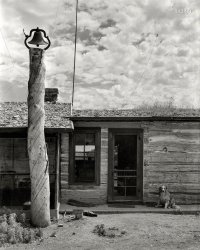
- "Wrecking": 1939
- ... 1939. "Blacksmith shop now used for auto repair. Glendive, Montana." A strong horseshoe motif here, architecturally speaking, in addition ... Posted by Dave - 12/09/2017 - 10:20am -
!["Wrecking": 1939 June 1939. "Blacksmith shop now used for auto repair. Glendive, Montana." A strong horseshoe motif here, architecturally speaking, in addition to the giant pile of actual horseshoes. Roofline of alphabetical anvils by Wile E. Coyote. "Wrecking" by "Joe Balison," who seems to be a fan of quote marks. Medium format negative by "Arthur Rothstein" for the "Farm Security Administration." View full size.
The vanishing blacksmithMy father-in-law was born and grew up in Glendive. His father ran a cartage business with mules and he would accompany him for deliveries in neighboring towns. He told me that he would arrive in a new place, and would stop and listen. The banging and clanging of the blacksmith could be heard anywhere and indicated the center of activity in town. He always headed for the noise. He joined the army in 1938, and when he returned after the war, all the blacksmith shops were gone or repurposed. This photo is an example of the change.
Anvils $Today just one of those anvils would be worth close to $1000.
[Those are plaster anvils. -Dave]
"Before" the "philistine" "Joe Balison"From a happier time, the C.S. Johnston Blacksmith shop, without any quotation marks and with all anvils still on parapet.
CrisafulliCrisafulli Inc., a metal fabricator and pump manufacturer, is in business in Glendive. With that name and location there has to be a connection!
GlendiveThe town has the distinction of being the smallest of the 210 television markets in the United States, according to Nielsen. It has 4,370 TV homes, well behind #209, which is North Platte, Nebraska, at 14,370.
truck ID1928-1929 Ford. The front doors are Ford car; the rest of the illfitting body aftermarket or salvaged from another make.
Any takers?I would bet big money the letters on those anvils were once horseshoes.
(The Gallery, Arthur Rothstein, Cars, Trucks, Buses, Horses)](https://www.shorpy.com/files/images/SHORPY-8b17793a.thumbnail.jpg)
- Cam Ham: 1937
- ... one of the grandsons of Mr. and Mrs. Baker. He lives in Montana. I talked to his wife. The family recently discovered this photo, plus ... Posted by Dave - 08/01/2018 - 12:02am -
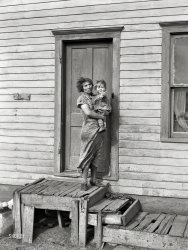
- Scandals of 1939
- Summer 1939. "Girlie show at carnival. Bozeman, Montana." 35mm negative by Arthur Rothstein for the Resettlement ... Posted by Dave - 09/20/2010 - 6:59pm -
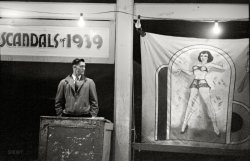
- Clicquot Club: 1913
- ... style with the billow pockets. Some of the hats are the Montana peak-style campaign hats, introduced in 1911. The canvas style ... Posted by Dave - 08/27/2012 - 1:17pm -
![Clicquot Club: 1913 "Boy Scouts, 1913." Harris & Ewing Collection glass negative. View full size.
Uniforms and accoutermentsThe blouses (or tunics) appear to be the M1909 spec. 1038 style with the billow pockets. Some of the hats are the Montana peak-style campaign hats, introduced in 1911. The canvas style leggings are the M1907 mounted.
By 1913, the year this photo was taken, the M1912 had become the standard military uniform. The M1912, M1917, and M1918 would all serve through the Great War. The M1910 leggings, and both wool and leather puttees would become standard. The campaign hat would remain in service through 1916, but most would not travel with the doughboys to Europe due to the bulk packing necessary to preserve its shape while being shipped.
As near as I can tell from the photo, the epulates [epaulets] have been removed from each uniform, which is how they were demilled for civilian use.
Boy Scout ranksThe boy on the far right has the scroll of a second class scout on his left sleeve. The third boy from the left appears to have the fleur-de-lis of a tenderfoot on his left pocket flap. The tall boy with the white shirt open at the throat also appears to have a rank on his coat pocket, but I can't make it out. Can we get a closeup?
Scout CoutureLove those garden-gnome hats.
Scout Uniforms, Cont'dIn response to the observations made by the US Victory Museum, the uniforms worn by these boys were manufactured specifically for the Scouts starting in 1910 by Sigmund Eisner Co. of Red Bank, N.J. Although Eisner also manufactured for the military, these were not made-over uniforms, never had epaulets, and were stamped and labeled on the inside of the garment with the Boy Scout seal. The hat, based on the "boss of the plains" design, was manufactured and labeled for the Scouts also starting in 1910. This was the official headwear of the Scouts until 1948, when it was replaced by the garrison cap (which had been used from the early 1940's as alternate headwear). The Scouts did make use of the military M1907 leggings until about 1915, when they changed to the "improved" canvas leggings with a single zigzag lace in the front, and woolen puttees and finally long socks.
(The Gallery, Boy Scouts, Harris + Ewing)](https://www.shorpy.com/files/images/03139a.thumbnail.jpg)
- The Lonesome Road: 1941
- August 1941. "Road with Homestead, Montana, and grain elevators on the horizon." Medium format negative by Marion ... Posted by Dave - 09/06/2019 - 7:01pm -
![The Lonesome Road: 1941 August 1941. "Road with Homestead, Montana, and grain elevators on the horizon." Medium format negative by Marion Post Wolcott for the Farm Security Administration. View full size.
Still a lonely placeSo isolated that even Google has not visited.
The grain silos appear to be present (there is no "street view"). The road is "Homestead Rd"/County Route 350 you are looking eastward towards Homestead.
I don't know where these folks shop for groceries -- the nearest town of any size, with stores, is Williston, North Dakota. Very isolated.
[They shop here. -Dave]
I can hear it nowAre we there yet?
Where's the curve?The photo had to be taken looking east from Route 350 west of Homestead, but there's no curve in the road now. Two of the grain elevators are still there.
Lonely RoadIndeed - hasn’t changed.
Try the Great Basin - More nothing.
Pole Pecker Trouble A woodpecker, on the pole nearest. Its mere presence disturbs the peace.
What's That in the Road? A Head?Whatever it is must be about 12 miles away
(The Gallery, Landscapes, M.P. Wolcott, Railroads)](https://www.shorpy.com/files/images/SHORPY-8c35941a.thumbnail.jpg)
- Stewart's Castle: 1900
- ... 1893. The house was sold to Senator William A. Clark from Montana, who demolished it with the intention of building a new residence; ... Posted by Dave - 09/12/2011 - 11:47am -
![Stewart's Castle: 1900 Washington circa 1900. "Stewart's Castle, Dupont Circle." The William Morris Stewart house on Massachusetts Avenue, designed by Adolph Cluss, shortly before it was demolished. National Photo glass negative. View full size.
Stewart's CastleStewart’s Castle at 1913 Massachusetts Avenue was built in 1873 for California [actually Nevada] Senator William Morris Stewart, who made his fortune in gold mining. Despite architect Adolph Cluss's intentions to imitate the wealth and glamour of European nobility, the castle proved to be too much of a financial burden and was leased to the Chinese government from 1886 to 1893. The house was sold to Senator William A. Clark from Montana, who demolished it with the intention of building a new residence; however, the land remained vacant until he sold it in 1921, and a bank was subsequently erected on the site.
-- Washington Places (University of Virginia)
BurnedAccording to the New York Times of December 31, 1879, the house burned down.
[The NYT article seems a bit confused. Iowa Circle (now called Logan Circle) was six blocks east of the Stewart house, which was on Dupont Circle at Massachusetts and Connecticut avenues. The residence, built in 1873, did indeed catch fire on the evening of December 30, 1879, but only the top floor was destroyed. - Dave]
Say it ain't so!Why was this beautiful creation destroyed so soon? It is one of the finer examples of architecture you'll ever see. Does anyone know the story?
Builded with Brick
Builded With Brick
Castle Stewart Being Restored
to More Than Original Splendor
Castle Stewart, built by the former Senator of that name from Nevada, on Dupont circle, when that now fine neighborhood was in its infancy, and burned some three years since, is being remodeled. The exterior will resume the imposing appearance possessed before the flames destroyed the upper story altogether, and ruined the plaster and woodwork of the interior. Mr. Robert I Fleming, the architect and builder, has the work in hand, and will make the restored mansion much handsomer that it ever was, and, what is more important, not liable to burn on such slight provocation, at least. The work, which is estimated to cost $25,000, is being done by Mrs. Stewart. In addition to the restoration, three dressing rooms, to be used in connection with the stage when private theatricals are to be given, are being erected; also a conservatory and a balcony on the Connecticut avenue front.
Washington Post, Jan 18, 1883
Where's Herman?I keep thinking if I look at the photo long enough, I'll see Herman, Lily, Eddie, Grandpa or another member of the Munster family show up at one of the windows. If I'm really lucky, Gomez and Morticia Addams might be there for a visit as well.
(The Gallery, D.C., Natl Photo)](https://www.shorpy.com/files/images/00061u.thumbnail.jpg)























